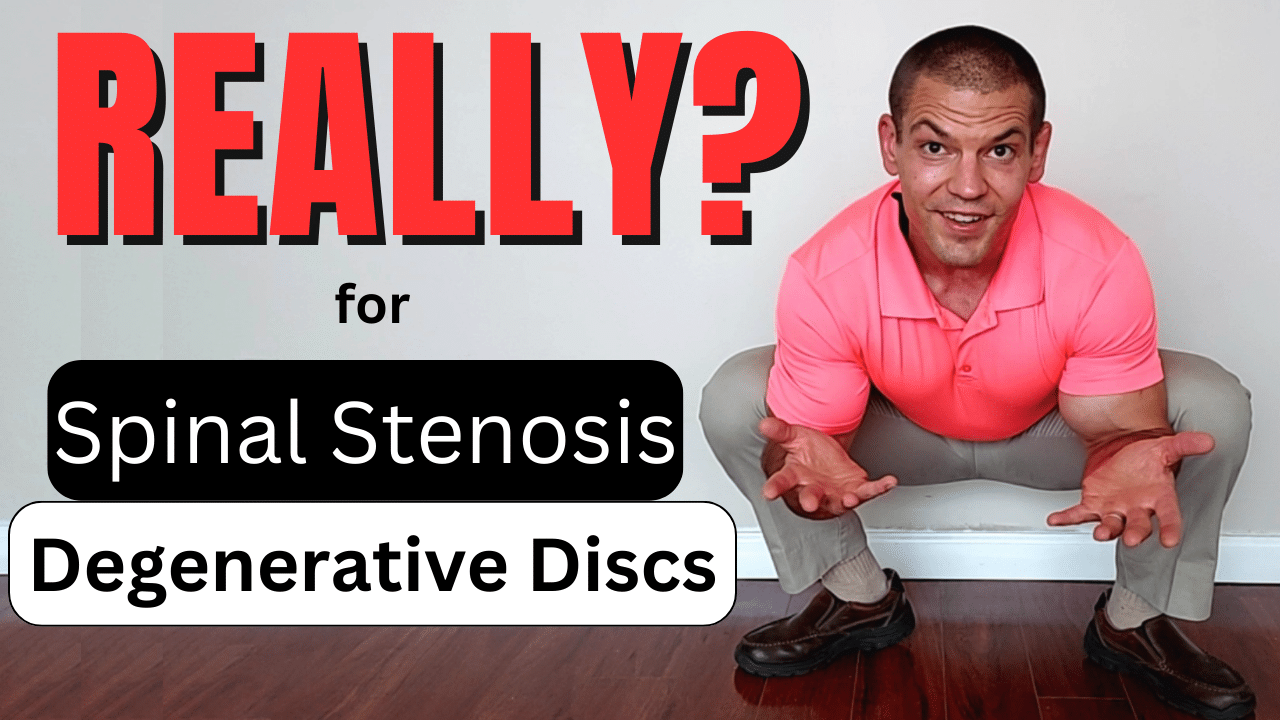Many people with spinal stenosis and degenerative disc disease have difficulty standing or walking for long periods of time. This is often due to excessive arch in their lower back.
Watch the video to learn an unusual but effective stretch for spinal stenosis and degenerative disc disease to relieve spine and leg pain fast.

Hip Opener Stretch For Spinal Stenosis and Degenerative Disc Disease
The hip opener stretch is commonly performed by weightlifters and other fitness enthusiasts to help them squat deeper.
However, if you're at the age where you have degenerative disc disease or spinal stenosis, you may have difficulty doing this stretch. That may be due to knee pain when squatting or just general difficulty getting up from the floor.
However, the hip opener exercise would be a great stretch for spinal stenosis and degenerative disc disease because it gets your lower back in a flexed position.
A lot of people who start having pain from degenerative disc disease or spinal stenosis have an excessive amount of of arch in their lower back.
This excessive extension can kink the spinal cord causing spinal stenosis as noted above.
Additionally, too much arch in the lower back can jam the facet joints in the lower back together, especially if you have degenerative disc disease.
That also narrows the spaces where the nerves to your legs exit your spine which can cause walking problems in people with spinal stenosis.
How This Stretch Helps Spinal Stenosis and Degenerative Disc Disease
If you have excessive arch in your lower back, it takes a lot of hip flexion or knee-to-chest motion to get that arch to flatten out.
When you get into a deep squat position like this, it allows you to get your chest between your legs. Conversely, when you're just doing a quadruped exercise, you get blocked by your knees.
Having a wide hip angle when you squat allows you to get farther into lumbar flexion, particularly a the lowest segments - L4, L5, and S1 - which are the most problematic spinal segments for people with degenerative disc disease and spinal stenosis.
Additionally, this exercises stretches your groin muscles as well as your piriformis, a muscle that runs over your sciatic nerve.
However, it's unlikely that someone in their 60s, 70s, or 80s, is going to do a deep squat unless they've stayed really fit.
So there's a great alternative that you can do sitting on a bed.
Modified Hip Opener Stretch For Spinal Stenosis and Degenerative Disc Disease
Here's how to do the same hip opener stretch sitting on a bed.
First of all, you want to sit with your knees in an outward angle as if you were squatting with your legs wide. Then grab your ankles with your hands.
Next, pull your ankles towards you, but not to the point where you're doing a complete groin stretch. Just pull until you feel a slight stretch.
Then the most important part of this exercise is just starting to pull yourself down into a lumbar flexion position.
If you look from a side view as you pull forwards like that, you get a lot of lower flexion.
Many people with spinal stenosis and degenerative disc disease have difficulty getting their spine to flex at L4-L5 and/or L5-S1.
However, this exercise allows you to get farther into lumbar flexion than other stretches for spinal stenosis and degenerative disc disease because you can get your chest and belly between your knees.
Just like the deep squat, this is also a good stretch for your groin muscles and piriformis.
In general, you want to hold this stretch for about 60 to 90 seconds total.
That may be three sets of 30 seconds or just one set of 60 or 90 seconds.
This stretch should feel good.
You should feel relief. It's not a "no pain, no gain" type of stretch.
However, this exercise is simply meant to relieve pain from spinal stenosis or degenerative disc disease.
It's not a cure.
In order to get lasting relief, you need to address the underlying root causes of the problem. These are the things that caused degenerative disc disease or the spinal stenosis in the first place.
That may be the way that you stand, the way that you walk, or the way that you lift.
There may be stiffness in certain muscles, particularly your hip flexors.
Need Help For Spinal Stenosis or Degenerative Disc Disease?
If you live in the St. Louis area and you need more help for degenerative disc disease or spinal stenosis, we'd be happy to help. Just tap the button below to request an appointment with one of our specialists.
Like this post? Check out some of our other post about exercises for lower back pain
Lean Forward When Walking? 3 Exercises to Stop Walking Hunched Over
Things To Avoid With Degenerative Disc Disease and What To Do Instead
8 Stretches For Lower Back Pain and Hip Mobility
7 Exercises For Arthritis In Lower Back








